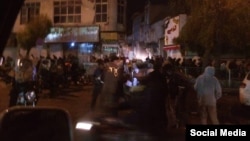Thousands of illegal substance users who have been released from Iran's rehabilitation centers due to coronavirus may be infected and spread the virus among the general population.
The centers were shut down by the decision of the National Coronavirus Combat Task Force to prevent outbreaks in crowded facilities with insufficient resources to deal with Covid-19 patients.
A video circulated on social media on Friday showing huge crowds of suspected drug users and dealers at Shush Square in the south of the capital has raised huge alarm. According to an official of Tehran Municipality four to five thousand drug addicts who had been undergoing treatment in government-funded rehabilitation and harm-reduction centers for "problem addicts" have been released in Tehran.
"Some of them insist on staying on the streets and decline to go to municipality-run homeless shelters," Malek Hosseini said. The shelters in Tehran are currently under great strain as the number of residents have hugely gone up due to the epidemic. Municipality shelters say the situation in shelters is under control and residents are regularly monitored for symptoms.
Video showing a big crowd at a Tehran square known as a hang-out of drug users and dealers.
Iran has been struggling with coronavirus pandemic since February which according to official figures has claimed at least 3,452 so far. The real death toll is much higher due to under-reporting as the Health Ministry bases its data solely on multiple positive test results for each person. According to data gathered by Radio Farda from local and national media as of April 3 at least 78,000 patients have been hospitalized across the country with symptoms of Covid-19 and more than 5,900 have died of complications associated with those symptoms.
Residents of rehabilitation centers where harm reduction services are also offered are often individuals with other serious problems including homelessness, and health issues such as HIV and Hepatitis.
Iran amended its narcotics law two years ago to make substance use tolerated as long as trafficking is not involved. However, persistent substance users arrested for other offenses such as using drugs in public are ordered by courts to sign up for rehabilitation to avoid going to prison.
Positioned on the trafficking route from Asia to Europe and at the heart of the infamous Golden Crescent of drug trafficking, Iran seizes more opium than any other country in the world. The price of heroin and opium, the drugs of choice in Iran, are very low due to the huge flow of these substances through the porous borders with the world's largest producer of opium, Afghanistan.
Rehabilitation centers offer treatment with methadone or buprenorphine to opiate users. The duration of stay in the center varies from one month to several months and at the end of the stay certificates of recovery are issued to produce for the courts. The country also runs a vast network of government-funded and private drop-in centers for treatment. Drop-in centers also offer harm reduction services such as distribution of clean needles, condoms and safe space for injection to intravenous drug users as well as basic medical care.
According to official figures there are at least 2.8 million regular users as well as 1.6 million recreational users among the country's population of 83 million. Some officials claim that the numbers are much higher. Many contend that the ban on alcohol since the Islamic Revolution of 1979 has aggravated Iran's drug abuse problem. Nevertheless, moonshine and smuggled alcohol is widely used. According to the World Health Organization (WHO) one percent of Iranians over the age of 15 suffered alcohol-use problems in 2016.
United Nations Office for Drugs and Crime (UNODC) in 2017 said Iran had seized more than 630 metric tons of opium alone which is more than 90 percent of the total global seizures. According to Hassan Norouzi, a lawmaker, Iranians use more than two metric tons of narcotic drugs per day. An official of the Narcotics Combat Task Force in 2019 said drug-trafficking has a turnover of five times the national budget of the country.










